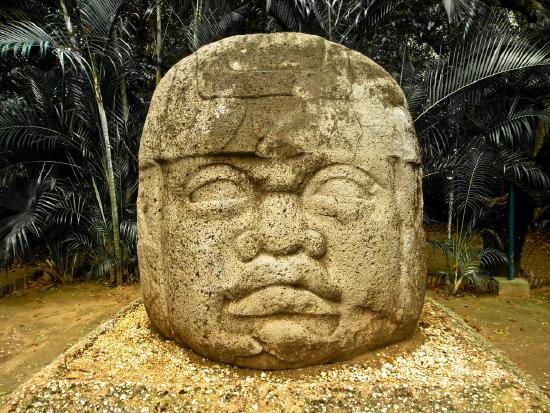2.1: Las cabeza colosales
- Page ID
- 44525

Y si tú quieres tener una cabeza colosal… ¡sigue aprendiendo español! Nuevos estudios científicos muestran que los cerebros de las personas que estudian una lengua extranjera generan nuevas neuronas. También, saber otra lengua nos ayuda a resolver los problemas y mejora la memoria a largo plazo y la memoria a corto plazo.
Before beginning this chapter, it is important to recognize which skills and tasks you will be expected to learn to perform. Do you already have some previous skills or knowledge in these areas that you can use to your advantage? Are there any topics that you foresee being difficult? If so, it is a good idea to pursue additional assistance to get ahead of any potential issues. You are the master of your education—you have the power to take ownership of your learning!
Distinguish between the different subject pronouns.
- Produce written and spoken sentences describing myself and others using the verb ser (to be) and adjectives that describe personality and physical characteristics.
- Employ the use of numbers between 0 and 100 to ask and answer questions.
- Express posession using the verb tener.
- Produce written and spoken sentences describing myself and others using the verb estar (to be) and adjectives that describe conditions, emotions, and feelings.
- Describe the location of places on campus in relation to one another.
- Discuss the world around me using the calendar, clock, and expressions for weather.
- Test my theories and assumptions about Spanish by using the language even when I am uncertain whether I am using it correctly.
Pre-chapter activity
Pre-activity: An important part of this chapter involves describing ourselves, as well as describing other people and groups. In this activity, you will follow the four steps outlined below in order to come up with a description of yourself, a partner, and the rest of the class.
During-activity:
Paso uno: Read the statements and check Sí or No depending on whether or not the statement accurately describes you.
1. Yo soy pesimista……………………………….
2. Yo soy optimista…………….…………………
3. Yo soy responsable…………………………....
4. Yo soy irresponsable. …………….…………....
5. Yo soy extrovertid@.……………..…………....
6. Yo soy introvertid@..................…. …………..
7. Yo soy activ@............................……………...
8. Yo soy creativ@.................................................
Paso dos: Use the questions provided to interview a classmate. Note their responses, making them negative when necessary by writing “no” in front of “es.”
1. ¿Eres tú pesimista?...................Mi compañer@ ___ es ________.
2. ¿Eres tú optimista?...................Mi compañer@ ___ es ________.
3. ¿Eres tú responsable?................Mi compañer@ ___ es ________.
4. ¿Eres tú irresponsable?..............Mi compañer@ ___ es ________.
5. ¿Eres tú extrovertid@?..............Mi compañer@ ___ es ________.
6. ¿Eres tú introvertid@?……...…Mi compañer@ ___ es ________.
7. ¿Eres tú activ@?........................Mi compañer@ ___ es ________.
8. ¿Eres tú creativ@?.....................Mi compañer@ ___ es ________.
Paso tres: Use the usted form of the same questions to interview a your instructor. Note their responses, making them negative when necessary by writing “no” in front of “es.”
1. ¿Es usted pesimista?..................Mi profesor/a ___ es ______________________________.
2. ¿Es usted optimista?..................Mi profesor/a ___ es _________________________.
3. ¿Es usted responsable?...............Mi profesor/a ___ es ________________________.
4. ¿Es usted irresponsable?.............Mi profesor/a ___ es ________________.
5. ¿Es usted extrovertid@?.............Mi profesor/a ___ es _______________________.
6. ¿Es usted introvertid@?……..…Mi profesor/a ___ es _______________________.
7. ¿Es usted activ@?.......................Mi profesor/a ___ es _______________________.
8. ¿Es usted creativ@?................Mi profesor/a ___ es _______________________.
Paso cuatro: Your instructor will poll the class using the questions provided. You will make note of how many classmates identify with each characteristic.
Número de estudiantes en la clase: ________
1. ¿Cuántos compañeros de clase son pesimistas?___________________
2. ¿Cuántos compañeros de clase son optimistas?________________________
3. ¿Cuántos compañeros de clase son responsables?________________________
4. ¿Cuántos compañeros de clase son irresponsables?________________________
5. ¿Cuántos compañeros de clase son extrovertidos?________________________
6. ¿Cuántos compañeros de clase son introvertidos?________________________
7. ¿Cuántos compañeros de clase son activos? ________________________
8. ¿Cuántos compañeros de clase son creativos?________________________
Paso cinco: Choose two characteristics that were discussed, then write two sentences describing the class in general terms. You may use the model as a guide.
Ej: Generalmente, los estudiantes (no) son idealistas.
1. ________
2. ________
Post-activity: Volunteers from the class will share their sentences from Paso cinco, as the instructor writes them on the board or projector, making any necessary corrections. Compare your sentences to the sentences provided by your instructor, making any necessary corrections to your original work.
With a partner or in a small group, discuss patterns you saw emerge in the way the language works. Then discuss the things you noticed as a class.


